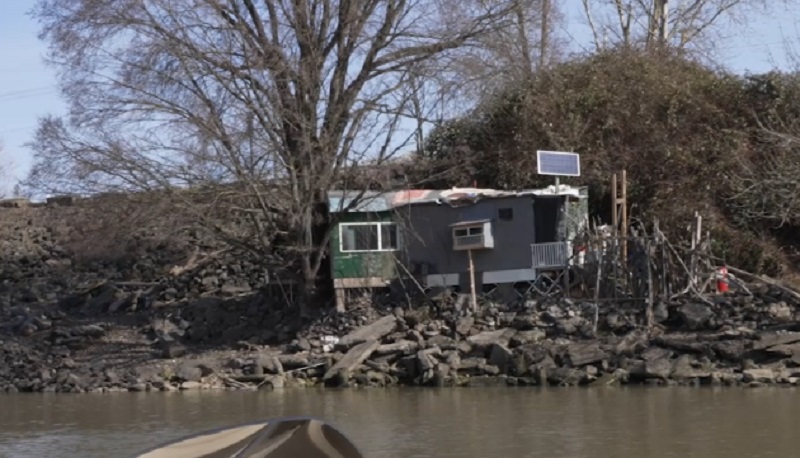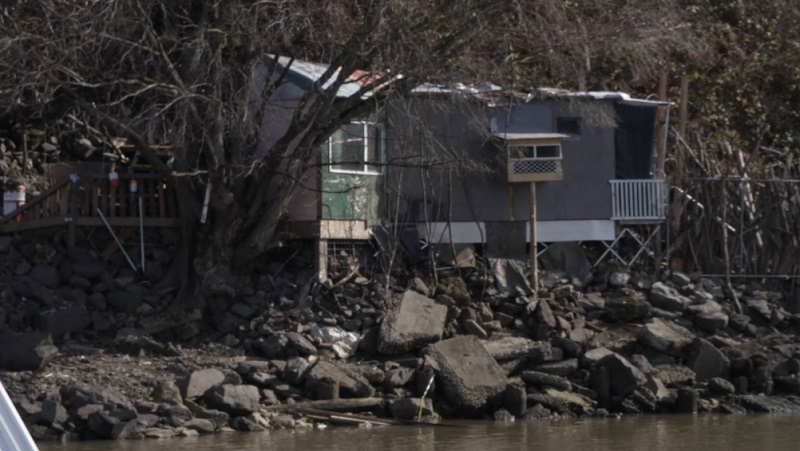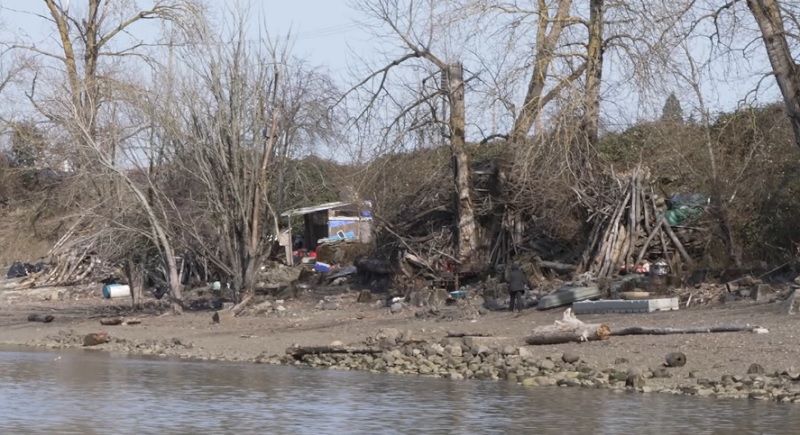PORTLAND, Ore. (KOIN) — For more than five years, Larry Purtle and Ric Scaramella have been watching from their condominium people living across the Willamette River in makeshift cabins, complete with doors and windows. Some have solar panels, and all have a million-dollar view of downtown Portland.
KOIN 6 News discovered the soil these cabins sit on is a sort of no-man’s land in the middle of a modern city.
From their windows, they can see “about nine structures,” Scaramella said. “These are not tents. These are structures.”
The couple is concerned for the people living with no services and whether pollution is going into the river. Since 2017, Scaramella estimates he’s called or complained to different government agencies “30, 40” times.
Two different worlds
The cabins are hard to reach. They are isolated by the adjacent Union Pacific railyard. KOIN 6 News traveled there by boat to get a closer look, with hopes of speaking with people living in the shacks. A person we saw inside one of the cabins did not come out to talk.
There are other structures made out of driftwood, which resemble beaver dams. We saw a man coming and going from one of them. He declined a chance to chat.
Farther downriver the KOIN 6 News crew saw other living structures and garbage strewn along the shore, including a boat with no trailer, a motorcycle and tarps.
On the beach in front of the nearby Daimler Truck North America headquarters was a woman who only gave her first name.
Paula.
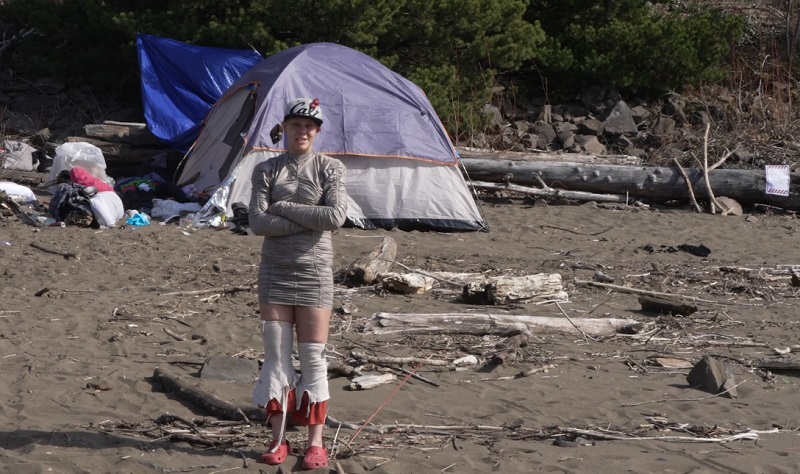
Paula has lived at her spot “off and on about a year-and-a-half,” and admitted sometimes it’s rough. Her life was set off course after a devastating break-up, she said.
“I have anxiety issues and I think I have personality disorders too, that I’m dealing with. I think that’s what’s kept me out here so long.”
Paula admitted she’s addicted to meth.
“There’s a few shelters I like. They would have been great, except for the no drugs thing. That sucks. I don’t think drugs are my problem,” she told KOIN 6 News. “I think my problem is I have no place to wash my hair and go to the bathroom.”
There are no bathroom facilities back upriver at the community of cabins.
Who’s in charge?
It’s not easy to figure out who regulates the shoreline — the city, county, state, the federal government and/or private property owners.
“Pretty much everyone comes back and says that they don’t have jurisdiction because it’s Union Pacific, it’s a railroad,” Scaramella said.
Complete statements from Union Pacific, Oregon Department of State Lands
are at the bottom of this article
Property records show this strip of beach along the Willamette River north of the Fremont Bridge appears to belong to Union Pacific.
In an email, Union Pacific spokesperson Daryl Bjoraas said “…this area is particularly challenging to enforce, because cabins are near the water’s edge. Under Ordinary High Water Mark common law, the boundary separating public land from private land is determined by natural fluctuations of the water, making it a legal gray area.”
The Oregon Department of State Lands, which regulates rivers, declined an interview request. Spokesperson Ali Ryan Hansen provided an email statement:
“The bad news is, at this point, it’s hard to say if we have a role. Where public ownership of the riverbed/bank ends and upland ownership begins is complicated.”
Hansen said property experts would need to visit the site and examine high- and low-water marks.
The City of Portland, which is in charge of cleaning up homeless camps, also declined an interview. The reason: this property belongs to Union Pacific, while other properties KOIN 6 News saw belong to the Port of Portland.
Lindbergh’s Beach
The area of beach the KOIN 6 News crew saw littered with garbage downriver from the cabins is an area called Lindbergh’s Beach, owned by the Port of Portland.
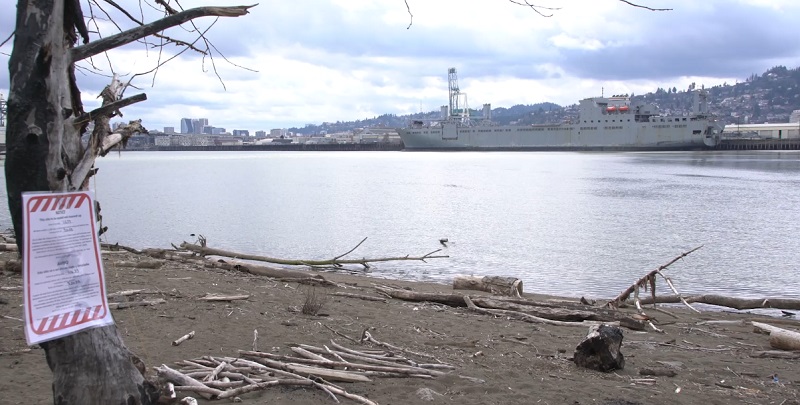
Several days after KOIN 6 News toured the area by boat, a joint effort between the City of Portland, the Oregon Department of State Lands, the Oregon Marine Board, Metro and the Port of Portland pulled out 10 tons of debris and 2 abandoned boats.
It was a massive effort, one that does not appear to be in the works for the community of cabins and the people who live in them.
Multnomah County funds non-profit organizations that do outreach with homeless people. A spokesperson said it is possible one of the groups has contacted the people living in the cabins but cannot say if that has happened.
Other agencies who regulate rivers in some way, such as the Oregon Department of Environmental Quality or the Army Corps of Engineers, told KOIN 6 News they don’t play a role in this.
‘People quick to be angry’
There is some encouraging news for Paula. She is on a waiting list for a county-sponsored rehab clinic and she hopes her spot opens soon.

“You get PTSD out here, for sure,” she said. “What do I say to people who are frustrated? You know love is everything. It’s how we treat each other. People are so quick to be angry.”
Statement from Union Pacific spokesperson Daryl Bjoraas
“Union Pacific Police regularly patrol our property and enforce trespassing laws; however, this area is particularly challenging to enforce, because cabins are near the water’s edge. Under Ordinary High Water Mark common law, the boundary separating public land from private land is determined by natural fluctuations of the water, making it a legal gray area.
“Homelessness is a challenging issue and a growing social problem that state and local governments are struggling to get their arms around. Despite efforts to keep our tracks clear and safe, unlawful encampments are set up, putting lives at risk and resulting in some people treating our property as a dump site. Union Pacific is committed to working with local, state, and federal agencies to address the issue as quickly as possible and in compliance with the law. Union Pacific encourages residents to rapidly report any observation of illegal trespassing or camping on railroad property via http://up.com/notifyup “
Statement from Oregon Department of State Lands spokesperson Ali Ryan Hansen
“The bad news is, at this point it’s hard to say if we have a role. Where public ownership of the riverbed/bank ends and upland ownership begins is complicated. Sometimes it’s to ordinary low water, which probably wouldn’t include the land the structures are on, and sometimes it’s to ordinary high water, which might include the land the structures were on but we wouldn’t be able to say definitively without our property experts reviewing the ownership records and visiting the site.”
